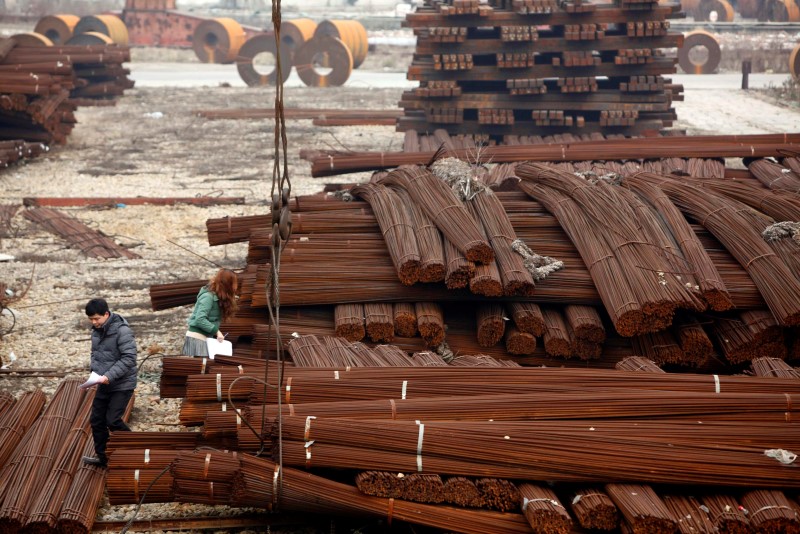(Repeats earlier story with no change in text. The opinions expressed here are those of the author, a columnist for Reuters)
By Clyde Russell
SYDNEY, Sept 17 (Reuters) - There's been considerable debate over who is right on the outlook for China's vast steel sector - the bullish iron ore miners or the bearish analysts and steel producers.
Rio Tinto (LONDON:RIO) RIO.AX , the Anglo-Australian miner that's likely to claim top spot among iron ore producers, has resolutely stuck to its view that China's steel output will top out at 1 billion tonnes per annum, around 2030.
There's been no shortage of people lining up to challenge that position, and even number three miner BHP Billiton (LONDON:BLT) BHP.AX has rowed back slightly from the 1 billion tonne forecast, to expecting peak output around 935 to 985 million tonnes in the mid-2020s.
The Chinese steel sector thinks peak steel was already achieved with last year's total of around 823 million tonnes, and is forecasting that output will slip slightly in coming years.
There are more bearish forecasts about, with one research house saying in a recent report that steel output will retreat to 650 million tonnes by 2017 as property demand falls back to levels before the stimulus prompted by the 2008 global recession.
But this is a debate that ultimately matters very little to Rio Tinto.
Other than pride and vindication for being correct, whether China reaches 1 billion tonnes of annual steel output is a moot point for Rio Tinto.
This is because Rio Tinto will be able to sell all of its iron ore production no matter what happens in China, and will be able to do so at a profit that is greater than its competitors.
This is the advantage you get from being the lowest cost producer in the industry.
Rio Tinto's production cost per tonne of iron ore will be $16.20 a tonne this year, $2 lower than a year ago, the company's China managing director Ren Binyan said last month.
It's likely that Rio Tinto will be able to cut a couple more dollars off the cost of mining each tonne as it ramps up its annual capacity to 360 million tonnes of the steel-making ingredient.
BHP is touting that its production cost will drop to $16 a tonne in the current financial year from around $19 in the prior year.
Adding in royalties and freight and the cost of a tonne or iron ore delivered to China rises to around $25 for the two major miners in Western Australia's iron ore heartland.
FAT PROFIT MARGINS
With the China spot price .IO62-CNI=SI at $56 a tonne on Wednesday, this means a margin of around $30 a tonne for both Rio Tinto and BHP.
While this is obviously down from the super profits being made when iron ore reached above $190 a tonne in early 2011, it's still an extremely fat margin for a mining business.
It also means that Rio Tinto and BHP can weather further weakness in the iron ore price, which has already dropped 21.3 percent this year, although it has rallied from the $44.10 reached on July 8, which was the lowest since spot assessments started in 2008.
There are plenty of calls for spot iron ore to decline further, especially as new iron ore output hits the market, not only from Rio Tinto, BHP and Brazil's Vale VALE5.SA , but also from the new Roy Hill mine in Western Australia.
The likelihood is that Rio Tinto's view on how much supply will be displaced by cheaper, new tonnes to market may also be too optimistic, but once again, this won't really matter too much to them.
Rio Tinto expects 120 million tonnes of high cost supply in China and elsewhere to leave the market in 2015, with a further 45 million tonnes at risk.
However, Chinese supply may be more sticky, given that many of the major mines are integrated with steel mills, and others will be able to continue mining at a loss because local governments will support them in order to keep miners employed.
Even if China's iron ore imports grow only modestly next year, and even if the price declines further, it's not Rio Tinto's executives that will be having sleepless nights.
The real question for the iron ore sector is not where Chinese steel output will peak, it's can prices fall far enough to knock out significant amounts of supply?
With Rio Tinto, BHP and Vale sitting at the lowest point on the cost curve, it's not their supply that will leave the market.
Companies with higher cost profiles and lower grade ore will be the ones nervously watching prices, probably none more so that number four producer Fortescue Metals Group FMG.AX .
It may be somewhat ironic that Fortescue will be hoping Rio Tinto's bullishness is correct, while Rio Tinto itself can afford to be agnostic about its own forecasts.
Disclosure: At the time of publication Clyde Russell owned shares in BHP Billiton and Rio Tinto as an investor in a fund. (Editing by Ed Davies)
